| 1 | Palestinian viper |
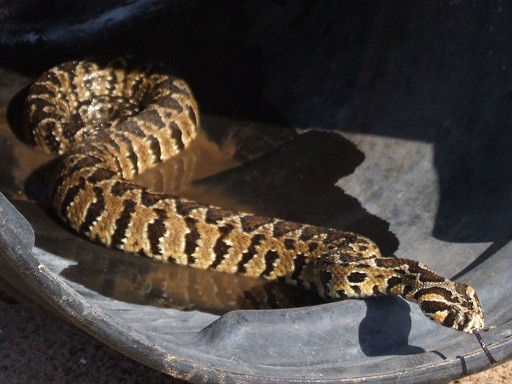
This most common venomous snake in Israel. This menacing species belongs to the same Daboia genus as the Russell’s viper of India, which possibly has the highest annual death toll of any snake on the planet. Thankfully, this Israeli species is milder, though still no picnic. They’re somewhat shorter at an average of 70-90cm, and a maximum of 130cm, meaning that less venom is injected. The symptoms include extreme pain, haemorrhaging, and respiratory failure in a small handful of cases.
The Palestinian viper (Daboia palaestinae) is abundant in northern and central Israel, skipping the south. They also inhabit Lebanon, western Jordan and western Syria. They prefer slightly moister habitats, rather than parched deserts. Hotspots for this species include agricultural areas, inland hills, shrubland and Mediterranean coastal plains.
In 2018, this species was chosen as the official national snake of Israel. Most Israeli hospitals stock the antivenom, as the threat of Daboia palaestinae is widely recognised. It’s impossible to live in the Palestinian viper’s territory without knowing about them.
A study comparing the two cousins found that Russell’s vipers outstripped the Palestinian viper for toxicity, with an LD50 rating of 0.20mg versus 0.34mg, although both were highly dangerous. Daboia palaestinae was highly haemorrhagic, causing lesions which became larger in direct correlation to the amount of venom used. Palestinian viper venom also caused noticeable cellular damage in the kidneys. A difference was that Palestinian vipers caused very little skin tissue necrosis compared to the Indian Russell’s viper (which is notorious for requiring amputations).
| 2 | Israeli worm snake |
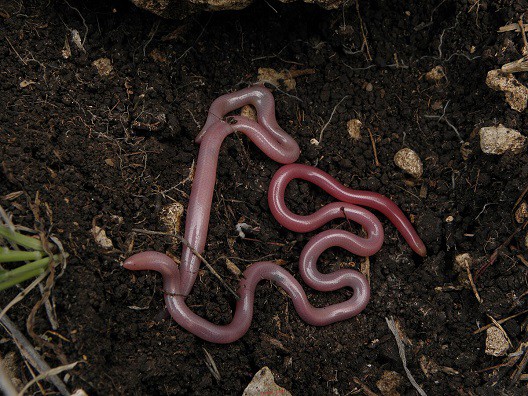
Israel’s main blind snake species. This snake has virtually no patterns, and a smooth, slimy appearance like an earthworm. The Israeli worm snake (Letheobia simonii) is one of the pinkest blind snakes you’ll see, and reaches a maximum of just 24cm, including the tail. It’s incredibly thin as well, with a diameter of 2-3mm. Rather than arid zones, this species appears in moister Mediterranean habitats like shrubland and grassland.
While technically classified as a snake alongside the anaconda or Egyptian cobra, the Israeli worm snake could not be more different. Its survival strategy depends completely on hiding in soil, beyond the talons of hungry predators, a plan which usually succeeds. Its range is almost entirely confined to Israel, particularly the central areas, including the West Bank. There’s only a small spillage of territory over the border with Jordan and Syria.
The Israeli blind snake has zero neck, as its head carries on seamlessly from its body like a tube. All blind snakes have feeble, shriveled eyes, which generally resemble miniscule pen dots, but in this species they’re actually invisible, as they’re hidden beneath two large ocular plates.
Instead, two tiny nostrils are visible, which might be mistaken for scales. Its head has a bizarre flute mouthpiece shape, with a sharpened snout, which is possibly involved with shifting soil aside. This minuscule species also appears in cultivated areas and gardens.
| 3 | Coin-marked snake |
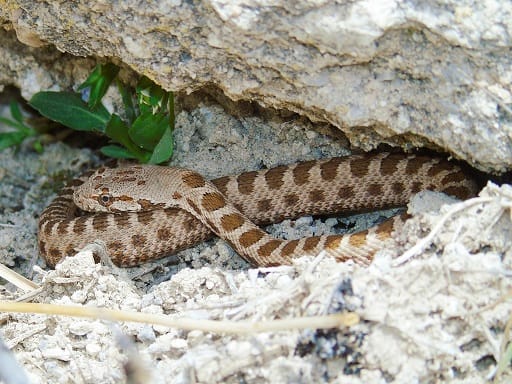
A common yet harmless Israeli snake, which reaches a maximum of 140cm and is more typically 100-110cm. Coin-marked snakes (Hemorrhois nummifer) are common in central and northern Israel, as well as Lebanon, Cyprus and Turkey.
This species belongs to the small Hemorrhois genus, which has 4 members, another being the horseshoe whipsnake of Spain and Portugal. Rather than shy burrowers, coin-marked snakes slither around confidently for all the world to see. They move by day (diurnal), and primarily inhabit open areas like shrubland and sparse woodlands.
There’s still a debate over whether this Israeli species has a mild venom. Some keepers have been chewed for ten seconds, ripped the snake off, and only experienced painful puncture wounds later. But an Iranian bite report mentioned minor swelling and redness on the affected limb.
This species was named after its round, coin-shaped markings. H. nummifer usually has an olive undertone, but in Iraq, fully black melanistic forms have been found, which are so dark they’ve been mistaken for the nearby Morgan’s black cobra. These super dark individuals may appear in Israel too, although here, coin-marked snakes have their own venomous species which they mimic: the Palestinian viper.
| 4 | Palestine kukri snake |
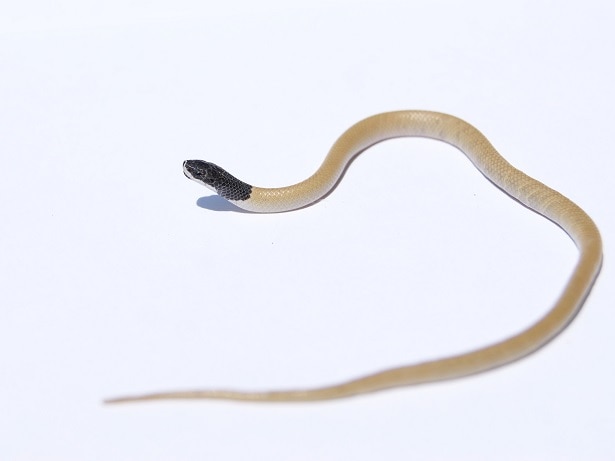
This 30cm, non-venomous serpent is easily recognisable by its jet black head. Its head is so dark that it looks like it’s been accidentally dunked in a pot of ink by an absent-minded writer, only to realise his mistake and toss it aside.
The Palestinian kukri snake (Rhynchocalamus melanocephalus) is found in most of Israel, as well as Lebanon and western Jordan, and spends the majority of its life underground. This is a secretive snake with only scraps of research to its name. They’re known to feed on ant eggs and larvae, and are usually spotted by people when lured to the surface by heavy rains.
Palestinian kukri snakes are usually found in hilly areas with dry loose soils and sparse bushes. These are often inbetween villages or next to old dirt roads – not quite in the middle of nowhere, but in sparsely inhabited rural zones. This species is believed to be under threat, as many of its old habitats have been converted to agricultural land. Nevertheless, this is the most common member of the 7-strong Rhynchocalamus snake genus, all of which have secretive habits.
Looking under loose rocks is the best method of finding this Israeli snake, but it’s never an easy quest. Being just 30cm doesn’t automatically make a snake harmless (see the Namqua dwarf adder of Namibia), but the Palestinian kukri snake is completely non-venomous. Their maximum known length is a mere 49.5cm. To the north, they reach southeast Turkey, while their southern limit is Egypt’s Sinai peninsular.
| 5 | Mueller’s two-headed snake |
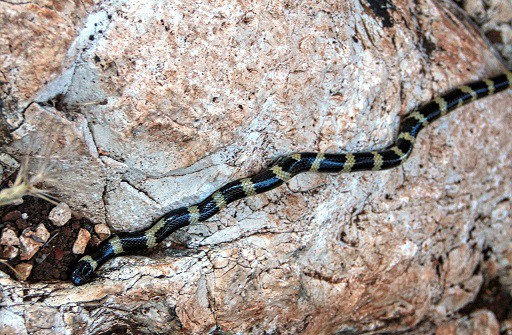
Israel has an abundance of burrowing, fossorial snakes which hardly anyone ever sees, and Mueller’s two-headed snake is yet another. This is a snake of vivid black and yellow (or white) bands, and a tail that strongly resembles the head, with the goal of confusing birds into a frantic debate about which one’s which.
Mueller’s two-headed snake (Micrelaps muelleri) avoids arid areas of Israel, and is mainly found in areas with soft soils, particularly Mediterranean habitats such as scrub, pine and oak woods. They’ve also been found under hay piles near wheat fields, and are found primarily in central and northern Israel, skipping the drier far south.
This species is nocturnal, reaches a maximum of 52cm, and is sluggish and slow-moving. Their diet is a mystery, with just scattered records: a European copper skink swallowed in captivity, and a Typhlops blind snake eaten by its close Somalian relative, the black-headed micrelaps. This snake will never invade someone’s bedroom in Tel Aviv, or chase after your car on a dusty highway – they’re a shy snake which always stays out of sight if possible.
Mueller’s two-headed snake is an egg-laying species, which is easy to recognise, if you actually find one. The curvy yellow-black bands are almost constant, except for an occasional morph that pops up with parallel lengthways stripes.
| 6 | Roth’s dwarf racer |
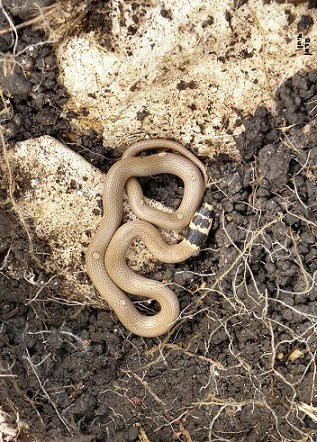
Another shy snake which lurks under cover at almost all times. Roth’s dwarf racer (Eirenis rothii) requires stones to survive, as it has a mortal fear of being exposed. Despite its racer title, this species never strides through the open Israeli countryside with no fear like a coin-marked snake.
Roth’s dwarf racer averages at 30cm, with a maximum of 42cm, and has similar habits to the Palestine kukri snake, appearing on dry hillsides, but also in forests and woods. Again, they have a plain body with a dense black head, though this time, the black is split up by small white markings.
Their diet includes whatever small prey they can fit inside their miniature bodies. This includes scorpions, centipedes, insects and spiders. Roth’s dwarf racer is also a rare snake in Europe or near Europe to hunt snails. This was confirmed in 1991, in a Roth’s dwarf snake found lurking under stones by the gates of a citrus orchard, near Netzer Sereni.
Adding more clues, their tail tapers to a fine point, which may be for skewering slimy prey, similarly to the USA’s sharp-tailed snake. Roth’s dwarf racers seem to lay very small egg totals, as two females laid just 2 large eggs per batch each.
| 7 | Large whipsnake |
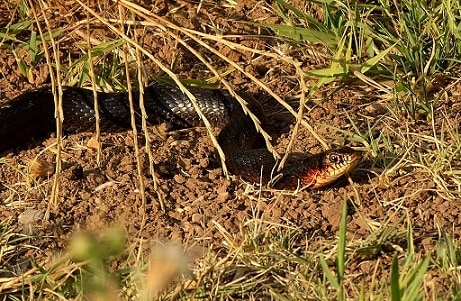
The longest snake in Israel, reaching a maximum of 250cm. Fortunately, they don’t use this brute size for bullying Israel’s inhabitants, as this is a non-venomous snake which mostly ignores you as long as you ignore them.
Large whipsnakes (Dolichophis jugularis) are found in moister areas of Israel, such as grassland, meadows, and sparse woods. They have a particular correlation with agricultural areas, where they’re sometimes caught in the gears of agricultural machinery and shredded. Other manmade habitats they occupy include vineyards and cemeteries.
Large whipsnakes are regularly sighted by Israeli locals, as they’re commonly found prowling the landscape for a varied menu of creatures. Their confirmed prey include common chameleons, black rats, European goldfinches, and even fellow snakes like eastern montpellier snakes and coin-marked snakes (also on this list).
This Israeli snake has the special feature of darkening massively with age. As juveniles, they feature shades of grey intermingled with white. In adulthood, dark shiny black takes over completely, usually after 3 or 4 years.
Large whipsnakes are concentrated in northern and central Israel, and further afield, they inhabit southern Turkey, Cyprus, Lebanon and northwest Jordan. They usually stick to the ground, but are easily agile enough to climb bushes and small trees, as well as bite people who harass them. In one sighting, a large whipsnake was recorded dying in Israel after unwisely swallowing a porcupine.
| 8 | Dice snake |
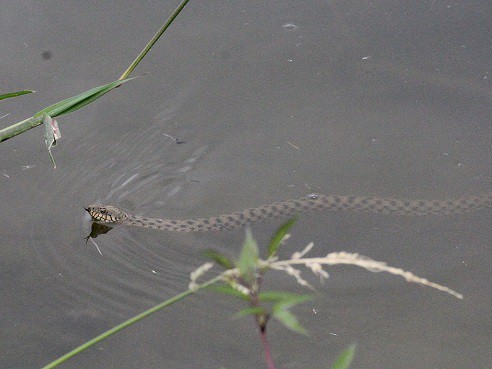
The ubiquitous European grass snake doesn’t have colonies in Israel, as it fizzles out just north of Lebanon, despite possessing a gigantic empire worldwide. However, their close relative the dice snake (Natrix tesselllata) does show up, inhabiting lakes and ponds, where it hunts for fish and amphibians.
This is the most water-loving snake on our list, and consequently, dice snakes totally avoid the barren deserts of Israel’s lower third. They inhabit moister areas of central and northern Israel, including the West Bank, and the moister Golan Heights close to the Syrian border. Dice snakes have been spotted alongside aquatic creatures such as Balkan terrapins, Levant water frogs, and Arabian tree frogs, and it’s likely that they feed on some of these.
Dice snakes measure 100-110cm, with a maximum of 130cm. Though mainly harmless, they have a very mild venom secreted through a Duvernoy’s gland, which must be chewed in repeatedly to take effect.
Dice snakes are famous for their varying colours. Those in the Histria ruins of Romania are primarily olive-green, while those near Golem Grad island in Macedonia tend to be spotted, with 13% fully black. Israel also has a wide variety of colours, but most seem to be dark olive and grey patterned forms.
The dice snake’s range begins in Germany to the northwest, and Israel lies almost at the southern extent of their territory. However, small colonies were recently discovered in Egypt’s Sinai peninsular, close to the Suez canal.
| 9 | Hoogstraal’s catsnake |
One of Israel’s rarer snakes. Hoogstraal’s catsnake (Telescopus hoogstraali) is a medium-sized snake measuring up to 102cm, which mainly inhabits the barren desert steppe of southern Israel. Their heartland is the cross border region between three countries: Israel, Jordan, and Egypt’s Sinai peninsular. This is a relative of the European catsnake (common in Greece), but is far more restricted in range.
Hoogstraal’s catsnake has a distinctive black head, with subtle white markings, contrasting against a plain grey body as an adult. As juveniles, they have thin dark markings which fade with age. Their black head clearly differentiates them from European catsnakes, while the black-headed catsnake (Telescopus nigriceps) found in Iraq and Syria has thick black bands covering its body.
With a narrow range, Hoogstraal’s catsnakes may be endangered, due to overgrazing by cattle or ending up as roadkill. But they’re probably kept alive by their remote desert locations, which mean that many colonies rarely interact with humanity. They also appear in dry shrubland and grassland, or even beneath rock piles in the ruins of old fortresses. Hoogstraal’s catsnakes have a cool ability to triangulate their head as well, mostly likely to mimic a viper. This species is incapable of killing a human.
| 10 | Field’s horned viper |
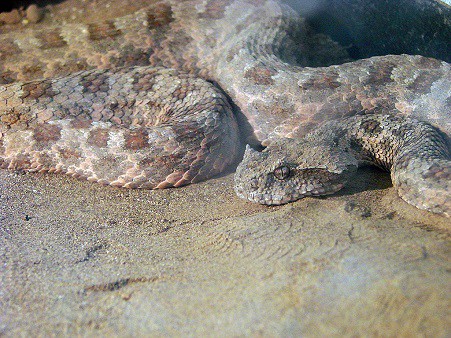
The Palestinian viper mainly inhabits central and northern Israel, but there’s no point in dashing for your car and driving straight into the freedom of southern Israel. If you do, you’ll bump straight into its replacement: Field’s horned viper (Pseudocerastes fieldi).
This is a desert-faring species which belongs to the 3-member Pseudocerastes genus, named because they have the same sharp horn as Cerastes vipers, but are only a distant cousin of them in reality. Field’s horned vipers inhabit a swathe of southern Israel, plus Egypt’s Sinai peninsula and western Jordan.
Pseudocerastes fieldi ranges from 60cm to a maximum of 89cm, and particularly likes sandy areas with sparse shrub cover. They’re active during dusk and night, and reports on their personality are mixed. Some mention a ferocious lunge with a piercing hiss, while others describe them as reluctant to enter battle, typically fleeing if agitated.
Either way, their venom has been analysed in detail. This species has a highly neurotoxic venom, which is rich in PLA2s, and low in the metalloproteinases (SVMPs) and serine proteinases (SVMPs) typical of rattlesnakes. This means that paralysis is more likely than haemorrhaging with Field’s horned viper.
Most vipers lay live young, but this is a rare species to lay eggs, typically in batches of 11-21. Field’s horned vipers have vertical pupils, and were originally considered to be a subspecies of the Persian horned viper (Pseudocerastes persica) further north. However, subtle scale differences confirmed them as independent, such as less ventral (belly) scales: 127–142 in Field’s horned viper versus 144-158 for the Persian. It’s estimated that Field’s horned vipers split off from their Persian cousin 12 million years ago.
